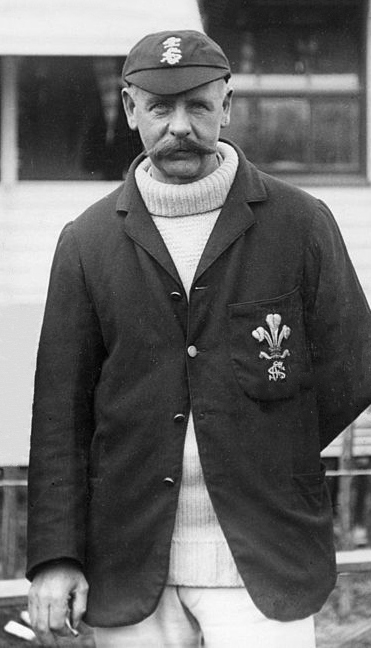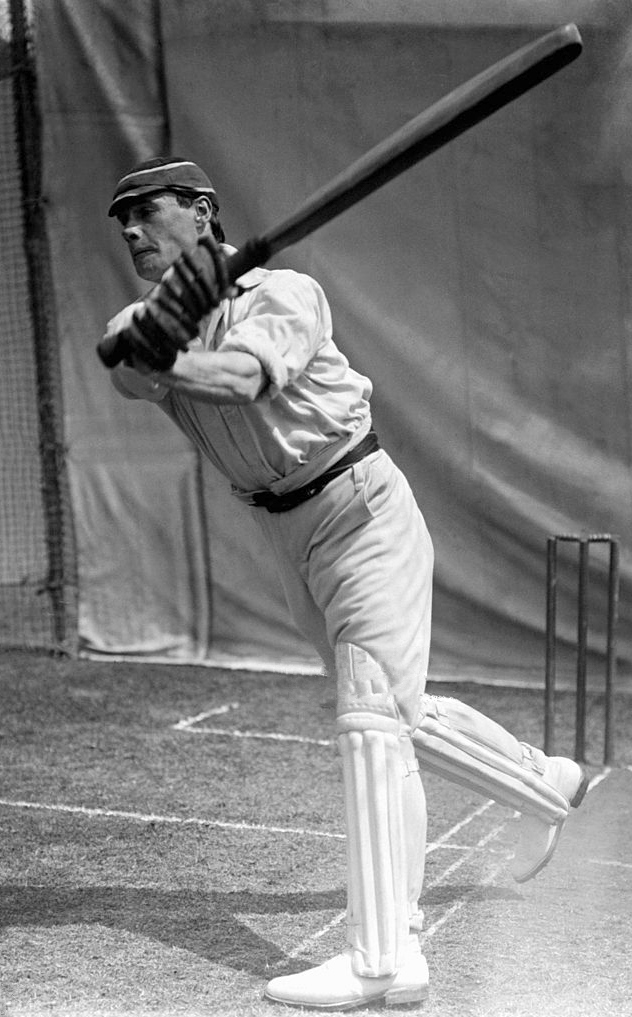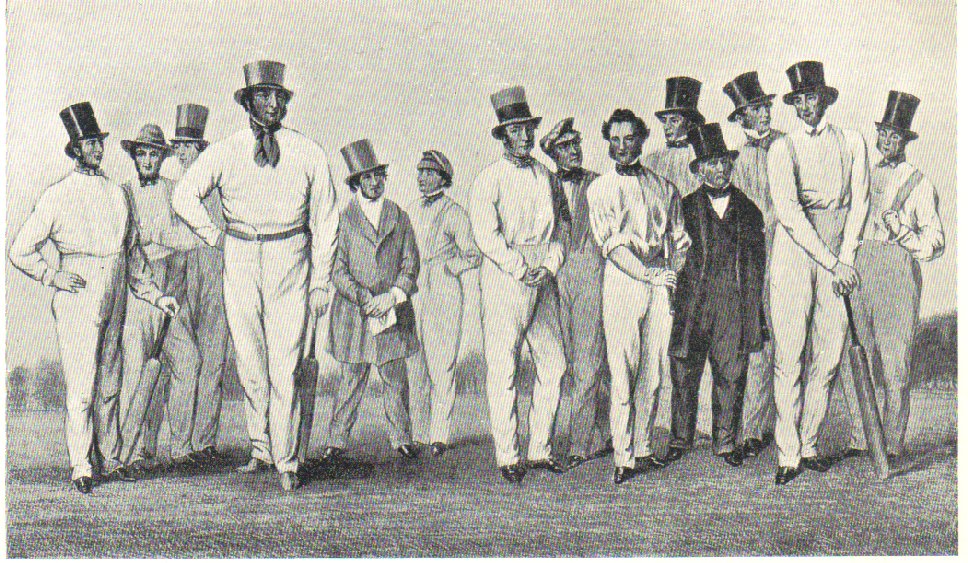|
Thomas Jayes
Thomas Jayes (17 April 1877 – 16 April 1913) was an English first-class cricketer who played for Leicestershire between 1903 and 1911. He was born and died at Ratby, Leicestershire. Jayes was a right-arm fast bowler and a hard-hitting lower middle-order right-handed batsman; unusually for fast bowlers of the era when he played, he was also rated as a good fielder. Early cricket Jayes made his debut for Leicestershire in a few games in 1903, but made little impression. He returned to the Leicestershire team in 1905 when John King was injured and in his second game he took 10 Essex wickets for 134 runs in an innings victory, including seven for 84 in the second innings. He retained his place when King returned and in 22 matches in 1905 took 102 wickets at an average of 23.79, a material part of Leicestershire's most successful season since they achieved first-class status in 1895. Against Derbyshire he took nine wickets for 78 runs in the Derbyshire second innings: five clean b ... [...More Info...] [...Related Items...] OR: [Wikipedia] [Google] [Baidu] |
Ratby
Ratby is a commuter village and civil parish in the Hinckley and Bosworth district of Leicestershire, England. It is situated to the west of Leicester, and just south of the M1 motorway. (Groby is on the northern side of the M1.) The population of the civil parish was measured in the 2011 census as 4,468. Other nearby places include Field Head, Kirby Muxloe, Glenfield and Markfield. The proximity of Ratby to Leicester causes it to form part of the Leicester Urban Area. Name Ratby is one of three nearby settlements whose name preserves the Brittonic word for "ramparts" (cf. Gaelic '' rath'' ), along with Ratcliffe-upon-Soar and the Roman ruins at Leicester, known as Ratae Corieltauvorum.Thompson, James''The History of Leicester, from the Time of the Romans to the End of the Seventeenth Century'', Appendix A: Ratæ—Roman Leicester, pp. 443 ff J. S. Crossley (Leicester), 1849. The suffix ''-by'' () is Old Norse for a farmstead or settlement. ... [...More Info...] [...Related Items...] OR: [Wikipedia] [Google] [Baidu] |
Warwickshire County Cricket Club
Warwickshire County Cricket Club is one of eighteen first-class county clubs within the domestic cricket structure of England and Wales. It represents the historic county of Warwickshire. Its T20 team is called the Birmingham Bears. Founded in 1882, the club held minor status until it was elevated to first-class in 1894 pending its entry into the County Championship in 1895. Since then, Warwickshire have played in every top-level domestic cricket competition in England. Warwickshire's kit colours are black and gold and the shirt sponsor is Gullivers Sports Travel. The club's home is Edgbaston Cricket Ground in south Birmingham, which regularly hosts Test and One-Day International matches. Honours First XI honours * County Championship (8) – 1911, 1951, 1972, 1994, 1995, 2004, 2012, 2021 :''Division Two'' (2) – 2008, 2018 * Gillette/NatWest/C&G/Friends Provident Trophy (5) – 1966, 1968, 1989, 1993, 1995 * Sunday/Pro 40 League/CB40/Royal London One-Day Cup ( ... [...More Info...] [...Related Items...] OR: [Wikipedia] [Google] [Baidu] |
Walter Brearley
Walter Brearley (11 March 1876 – 30 January 1937) was an English first-class cricketer who played for Lancashire and England. Brearley was a fast bowler with what ''Wisden'' described as "a rolling gait" who put his full – and substantial – weight into achieving pace and swing. He played county cricket only from the age of 26, but his ability to make the ball rise sharply on the somewhat fiery Old Trafford wickets became noticed the following year, but after the wickets became less difficult he was dropped from the side. The following year, his bowling was a valuable part of Lancashire's finest season in county cricket (sixteen wins and no losses) but his inability to play late in the season attracted the notice of ''Wisden''. The following year, he improved even further – at times bowling well even on wickets too dead to suit a fast bowler. A superb display of pace and length against Somerset at Old Trafford made him an automatic choice for the Test team for the Fourt ... [...More Info...] [...Related Items...] OR: [Wikipedia] [Google] [Baidu] |
Sydney Pardon
Sydney Herbert Pardon (23 September 1855 – 20 November 1925) was a sports journalist who was the editor of ''Wisden Cricketers' Almanack'' for 35 editions, from 1891 until his death. His father was the journalist George Frederick Pardon. He took over the editorship of ''Wisden'' following the death of his brother, Charles. Of all the editors of the publication, he was arguably the greatest. He introduced the "Notes by the Editor" feature in 1901, and did much to get throwing, a major problem in the 1890s, stamped out. L. E. S. Gutteridge wrote of him: "His was a cultured mind. He had definite opinions and was prepared to state them. His editorials make most interesting reading and his influence on the growth of the game throughout the world was immense." In 1892, he introduced a comprehensive obituary section. In 1896, for the first time ''Wisden'' appeared in a cloth-bound (hardback) edition as well as paperback. In 1910 he memorably wrote that the England selectors had "to ... [...More Info...] [...Related Items...] OR: [Wikipedia] [Google] [Baidu] |
The Ashes
The Ashes is a Test cricket series played between England and Australia. The term originated in a satirical obituary published in a British newspaper, ''The Sporting Times'', immediately after Australia's 1882 victory at The Oval, its first Test win on English soil. The obituary stated that English cricket had died, and "the body will be cremated and the ashes taken to Australia". The mythical ashes immediately became associated with the 1882–83 series played in Australia, before which the English captain Ivo Bligh had vowed to "regain those ashes". The English media therefore dubbed the tour ''the quest to regain the Ashes''. After England had won two of the three Tests on the tour, a small urn was presented to Bligh by a group of Melbourne women including Florence Morphy, whom Bligh married within a year.Summary of Events '' |
Tom Hayward
Thomas Walter Hayward (29 March 1871 – 19 July 1939) was an English first-class cricketer who played for Surrey and England between the 1890s and the outbreak of World War I. He was primarily an opening batsman, noted especially for the quality of his off-drive. Neville Cardus wrote that he "was amongst the most precisely technical and most prolific batsmen of any time in the annals of cricket."Barclays World of Cricket – 2nd Edition, 1980, Collins Publishers, , p172. He was only the second batsman to reach the landmark of 100 first-class centuries, following WG Grace. In the 1906 English season he scored 3,518 runs, a record aggregate since surpassed only by Denis Compton and Bill Edrich in 1947. Career Born 29 March 1871 in Cambridge Hayward came from a cricketing family: his grandfather, father and uncle had all played first-class cricket.His grandfather Daniel played (1832–1851) for Cambridge Town Club, Surrey and Marylebone Cricket Club (MCC); his father (also Dani ... [...More Info...] [...Related Items...] OR: [Wikipedia] [Google] [Baidu] |
Gilbert Jessop
Gilbert Laird Jessop (19 May 1874 – 11 May 1955) was an English cricket player, often reckoned to have been the fastest run-scorer cricket has ever known. He was Wisden Cricketer of the Year for 1898. Career Jessop was born in Cheltenham, Gloucestershire. Nicknamed "The Croucher" because of his unusual hunched stance at the crease and though a stocky build at 5'7" and 11 stone, he remained a fast bowler through his career. He was also a powerful driver, cutter and hooker. The Fifth Test at The Oval in August 1902, known as "Jessop's match", highlighted Jessop's ability to play quickly. England had an unlikely one-wicket victory against a quality Australian side who set England 263 to win in the fourth innings. Jessop came to the crease with England at 48 for 5. He scored his first 50 runs in 43 minutes and reached his century in 75 minutes. He was eventually dismissed after 77 minutes for 104, which included 17 fours and an all-run five. Many of the fours had well cleared the ... [...More Info...] [...Related Items...] OR: [Wikipedia] [Google] [Baidu] |
Lord's
Lord's Cricket Ground, commonly known as Lord's, is a cricket venue in St John's Wood, London. Named after its founder, Thomas Lord, it is owned by Marylebone Cricket Club (MCC) and is the home of Middlesex County Cricket Club, the England and Wales Cricket Board (ECB), the European Cricket Council (ECC) and, until August 2005, the International Cricket Council (ICC). Lord's is widely referred to as the ''Home of Cricket'' and is home to the world's oldest sporting museum. Lord's today is not on its original site; it is the third of three grounds that Lord established between 1787 and 1814. His first ground, now referred to as Lord's Old Ground, was where Dorset Square now stands. His second ground, Lord's Middle Ground, was used from 1811 to 1813 before being abandoned to make way for the construction through its outfield of the Regent's Canal. The present Lord's ground is about north-west of the site of the Middle Ground. The ground can hold 31,100 spectators, the capacity ... [...More Info...] [...Related Items...] OR: [Wikipedia] [Google] [Baidu] |
Australian Cricket Team In England In 1909
The Australian cricket team in England in 1909 played 42 first-class cricket, first-class matches, including five Test cricket, Test matches to contest The Ashes. Australia was captained by Monty Noble, England cricket team, England by Archie MacLaren. The third Test of the series, at Headingley, was the 100th Test match to be played by England. Test series summary Australia won the Test series 2–1, with two matches drawn. First Test Second Test Third Test Fourth Test Fifth Test References Further reading * Wisden Cricketers' Almanack 1910 * Bill Frindall, ''The Wisden Book of Test Cricket 1877-1978'', Wisden, 1979 * Chris Harte, ''A History of Australian Cricket'', Andre Deutsch, 1993 * Ray Robinson, ''On Top Down Under'', Cassell, 1975 External links CricketArchive – tour summaries 1909 in Australian cricket 1909 in English cricket International cricket competitions from 1888–89 to 1918 Australian cricket tours of England, 1909 English cricket se ... [...More Info...] [...Related Items...] OR: [Wikipedia] [Google] [Baidu] |
England National Cricket Team
The England cricket team represents England and Wales in international cricket. Since 1997, it has been governed by the England and Wales Cricket Board (ECB), having been previously governed by Marylebone Cricket Club (the MCC) since 1903. England, as a founding nation, is a Full Member of the International Cricket Council (ICC) with Test, One Day International (ODI) and Twenty20 International (T20I) status. Until the 1990s, Scottish and Irish players also played for England as those countries were not yet ICC members in their own right. England and Australia were the first teams to play a Test match (15–19 March 1877), and along with South Africa, these nations formed the Imperial Cricket Conference (the predecessor to today's International Cricket Council) on 15 June 1909. England and Australia also played the first ODI on 5 January 1971. England's first T20I was played on 13 June 2005, once more against Australia. , England have played 1,058 Test matches, winning 387 and lo ... [...More Info...] [...Related Items...] OR: [Wikipedia] [Google] [Baidu] |
Test Cricket
Test cricket is a form of first-class cricket played at international level between teams representing full member countries of the International Cricket Council (ICC). A match consists of four innings (two per team) and is scheduled to last for up to five days. In the past, some Test matches had no time limit and were called Timeless Tests. The term "test match" was originally coined in 1861–62 but in a different context. Test cricket did not become an officially recognised format until the 1890s, but many international matches since 1877 have been retrospectively awarded Test status. The first such match took place at the Melbourne Cricket Ground (MCG) in March 1877 between teams which were then known as a Combined Australian XI and James Lillywhite's XI, the latter a team of visiting English professionals. Matches between Australia national cricket team, Australia and England cricket team, England were first called "test matches" in 1892. The first definitive list of retro ... [...More Info...] [...Related Items...] OR: [Wikipedia] [Google] [Baidu] |
The Oval
The Oval, currently known for sponsorship reasons as the Kia Oval, is an international cricket ground in Kennington, located in the borough of Lambeth, in south London. The Oval has been the home ground of Surrey County Cricket Club since it was opened in 1845. It was the first ground in England to host international Test cricket in September 1880. The final Test match of the English season is traditionally played there. In addition to cricket, The Oval has hosted a number of other historically significant sporting events. In 1870, it staged England's first international football match, versus Scotland. It hosted the first FA Cup final in 1872, as well as those between 1874 and 1892. In 1876, it held both the England v. Wales and England v. Scotland rugby international matches and, in 1877, rugby's first varsity match. It also hosted the final of the 2017 ICC Champions Trophy. History The Oval is built on part of the former Kennington Common. Cricket matches were playe ... [...More Info...] [...Related Items...] OR: [Wikipedia] [Google] [Baidu] |





